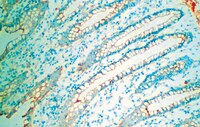Definition of the native and denatured type II collagen binding site for fibronectin using a recombinant collagen system.
An, B; Abbonante, V; Yigit, S; Balduini, A; Kaplan, DL; Brodsky, B
The Journal of biological chemistry
289
4941-51
2014
Show Abstract
Interaction of collagen with fibronectin is important for extracellular matrix assembly and regulation of cellular processes. A fibronectin-binding region in collagen was identified using unfolded fragments, but it is not clear if the native protein binds fibronectin with the same primary sequence. A recombinant bacterial collagen is utilized to characterize the sequence requirement for fibronectin binding. Chimeric collagens were generated by inserting the putative fibronectin-binding region from human collagen into the bacterial collagen sequence. Insertion of a sufficient length of human sequence conferred fibronectin affinity. The minimum sequence requirement was identified as a 6-triplet sequence near the unique collagenase cleavage site and was the same in both triple-helix and denatured states. Denaturation of the chimeric collagen increased its affinity for fibronectin, as seen for mammalian collagens. The fibronectin binding recombinant collagen did not contain hydroxyproline, indicating hydroxyproline is not essential for binding. However, its absence may account, in part, for the higher affinity of the native chimeric protein and the lower affinity of the denatured protein compared with type II collagen. Megakaryocytes cultured on chimeric collagen with fibronectin affinity showed improved adhesion and differentiation, suggesting a strategy for generating bioactive materials in biomedical applications. | 24375478
 |
Migration-stimulating factor: a genetically truncated onco-fetal fibronectin isoform expressed by carcinoma and tumor-associated stromal cells.
Seth L Schor, Ian R Ellis, Sarah J Jones, Robin Baillie, Kanjula Seneviratne, Julia Clausen, Katsumi Motegi, Borek Vojtesek, Katerina Kankova, Elizabeth Furrie, Mark J Sales, Ana M Schor, Richard A Kay
Cancer research
63
8827-36
2003
Show Abstract
Migration-stimulating factor (MSF) is a 70-kDa motogenic protein previously reported to be expressed by fetal and cancer patient fibroblasts cultured in vitro and present in the serum of breast cancer patients. A 2.2-kb full-length MSF cDNA has been cloned and shown to be a truncated isoform of fibronectin generated from its primary gene transcript by a hitherto unrecognized intron read-through mechanism. MSF cDNA is identical to the 5' end of fibronectin cDNA, up to and including exon III-1a, and terminates in a novel 195-nucleotide 3' sequence. This MSF unique sequence is derived from the intron immediately downstream of exon III-1a in the fibronectin gene and is not found in any previously identified full-length fibronectin cDNA. MSF mRNA is 1000-fold less abundant than full-length fibronectin message in fetal fibroblasts and exhibits rapid biphasic decay kinetics previously associated with oncogenes and stress response molecules. MSF recombinant protein exhibits a potent and substratum-dependent motogenic activity, with half-maximal response manifest at 0.1-1.0 pg/ml. This activity is (a) mediated by the IGD amino acid motif; and (b) not expressed by (i.e., cryptic within) full-length fibronectin. In situ hybridization and immunohistochemistry confirm that MSF is expressed by tumor-associated fibroblasts and additionally indicate that it is also expressed by carcinoma cells and tumor-associated vascular endothelial cells. MSF, as a consequence of its potent bioactivities and expression by both stromal and carcinoma cell populations, is well placed to function as an epigenetic effector promoting cancer development. | 14695199
 |
Preferential recognition of a fragment species of osteoarthritic synovial fluid fibronectin by antibodies to the alternatively spliced EIIIA segment.
J H Peters, S Carsons, K Kalunian, S McDougall, M Yoshida, F Ko, M van der Vliet-Hristova, T J Hahn
Arthritis and rheumatism
44
2572-85
2001
Show Abstract
OBJECTIVE: To characterize the species of synovial fluid (SF) fibronectin (FN) bearing the alternatively spliced EIIIA segment. METHODS: SF from patients with osteoarthritis (OA) and rheumatoid arthritis (RA), as well as corresponding affinity isolation products, were subjected to 1-dimensional and 2-dimensional electrophoresis followed by Western blot analysis. RESULTS: Regardless of the clinical type of arthritis, a polyclonal antibody that recognizes antigenic determinants throughout the FN molecule produced staining of predominantly approximately 200+ and approximately 170-kd species in reduced 1-dimensional electrophoresis. Despite the overall prevalence of the larger species, 4 monoclonal antibodies (mAb) reactive with sequences lying near the center of the EIIIA segment exhibited a relative failure to recognize the larger of these 2 species in OA, but not RA, SF. The absence of recognition of EIIIA sequences within the approximately 200+ kd forms of OA SF FN was unrelated to their derivation from dimers, since anti-EIIIA mAb recognized the smaller fragment species in preference to both monomeric and dimeric forms. The approximately 170-kd EIIIA+ fragments were observed to have minimal gelatin-binding capacity and appeared on 2-dimensional electrophoresis to extend from the N-terminus of FN through at least the center of the EIIIA segment. Similar results were obtained for samples obtained by needle aspiration or arthroscopic lavage, suggesting a widespread applicability of these findings. CONCLUSION: The approximately 170-kd EIIIA+ species of FN could potentially constitute a soluble vehicle by which chondrocyte-regulating EIIIA sequences, liberated from inhibitory flanking C-terminal sequences, could reach cells in the arthritic joint. Additionally, FN species-specific recognition of this segment within OA SF could constitute a marker by which to gauge the activity of the OA disease process. | 11710714
 |











